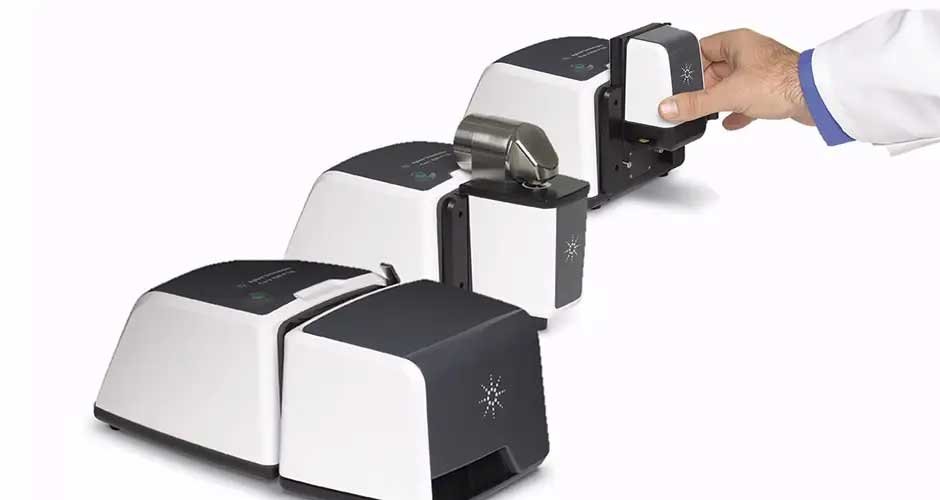Fourier Transform Infrared (FTIR) spectroscopy is a versatile analytical technique widely used in various scientific disciplines. Agilent Technologies, a renowned provider of analytical instruments, offers a range of cutting-edge FTIR spectroscopy instruments.
This comprehensive blog post will delve into the typical applications of Agilent FTIR spectroscopy instruments and highlight their significance in different fields.
Pharmaceutical Analysis
FTIR instruments find extensive use in pharmaceutical analysis. They enable identifying and quantifying active pharmaceutical ingredients (APIs), excipients, and impurities in drug formulations.
FTIR spectroscopy allows researchers to analyze pharmaceutical compounds’ chemical structure and functional groups, aiding drug development and quality control. FTIR instruments provide high sensitivity, speed, and accuracy, making them ideal for pharmaceutical analysis.
Researchers also employ FTIR spectroscopy instruments to study drug-excipient compatibility, monitor storage stability, and evaluate drug delivery systems’ effectiveness. The ability to rapidly analyze solid-state forms, such as crystalline and amorphous forms, polymorphs, and hydrates, contributes to understanding drug properties and formulation optimization.
Environmental Monitoring
Environmental monitoring and analysis are crucial for assessing the quality of air, water, and soil. FTIR spectroscopy instruments play a vital role in this domain by facilitating the detection and quantification of pollutants and contaminants.
With FTIR, researchers can identify various organic and inorganic compounds, including volatile organic compounds (VOCs), pesticides, heavy metals, and atmospheric gases.
Advanced FTIR instruments offer enhanced sensitivity, reliability, and versatility, enabling accurate environmental monitoring. They allow real-time analysis of air pollutants, detection of water contaminants, and soil analysis. Additionally, FTIR spectroscopy can assist in tracking the sources and fate of contaminants, aiding environmental remediation efforts and regulatory compliance.
Food Safety and Quality Control
Ensuring food safety and quality is of paramount importance in the food industry. FTIR instruments are extensively used in food analysis to assess products’ composition, authenticity, and contamination.
FTIR spectroscopy identifies additives, preservatives, pollutants, and contaminants in food samples. It can also detect the presence of allergens and determine the nutritional content of food.
FTIR instruments provide rapid and precise analysis, assisting in maintaining food safety standards. They facilitate detecting foodborne pathogens, verifying food authenticity, and monitoring food processing parameters. FTIR spectroscopy is also used for analyzing food packaging materials to ensure compliance with regulatory requirements and prevent the potential migration of harmful substances into food.
Forensic Analysis
FTIR spectroscopy instruments contribute significantly to evidence analysis and crime scene investigations in forensic science. They help identify unknown substances, such as drugs, explosives, fibers, paints, and trace evidence. FTIR spectroscopy can differentiate materials based on their unique infrared spectra, establishing links between crime scenes, suspects, and victims.
FTIR instruments offer excellent sensitivity and resolution, enabling forensic scientists to obtain critical information from trace samples.
They assist in characterizing illicit drugs, analyzing gunshot residue, identifying fibers from clothing or carpets, and examining questioned documents. FTIR spectroscopy and advanced chemometric techniques enhance forensic analyses’ discriminatory power and reliability.
Material Characterization
FTIR spectroscopy is widely utilized for material characterization across various industries. FTIR instruments assist in analyzing polymers, plastics, rubbers, coatings, textiles, and composites.
Researchers can examine different materials’ chemical compositions, molecular structures, and functional groups. FTIR spectroscopy aids in quality control, troubleshooting, and research and development efforts, ensuring material performance and integrity.
FTIR instruments offer advanced capabilities such as micro-sampling, mapping, and imaging, enabling the detailed analysis of material surfaces and interfaces.
Researchers can study the effects of processing conditions, aging, and environmental exposure on materials. FTIR spectroscopy also facilitates the identification of contaminants, monitoring of degradation processes, and characterization of nanomaterials.
Polymers and Plastics Analysis
FTIR spectroscopy is extensively utilized for the analysis of polymers and plastics. These materials have complex molecular structures, and FTIR spectroscopy provides valuable insights into their chemical composition, functional groups, and structural characteristics.
By analyzing the infrared spectra of polymers, researchers can identify different types of polymers, monitor polymer degradation, determine the presence of additives or contaminants, and assess the quality and performance of polymer materials.
FTIR instruments with specialized accessories, such as attenuated total reflectance (ATR) or transmission cells, enable an easy and non-destructive analysis of polymer samples.
This application finds relevance in industries such as packaging, automotive, construction, and textiles, where accurate characterization of polymer materials is essential for product development, quality control, and performance evaluation.
Art and Cultural Heritage Conservation
FTIR spectroscopy plays a significant role in preserving and restoring art and cultural heritage artifacts. This non-invasive analytical technique allows researchers to analyze and identify the chemical composition of various materials used in artwork, historical artifacts, and archaeological findings.
By studying the infrared spectra of pigments, dyes, binders, varnishes, and coatings, FTIR spectroscopy aids in authentication, dating, and conservation efforts.
Conclusion
Agilent FTIR spectroscopy instruments find broad applications in numerous scientific and industrial fields. Agilent’s FTIR instruments offer powerful analytical capabilities from pharmaceutical analysis to environmental monitoring, food safety to forensic investigations, and material characterization to research and development. Their accuracy, sensitivity, and speed make them indispensable tools for scientists, researchers, and industry professionals.






